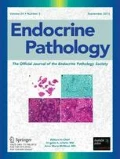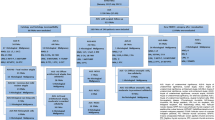Abstract
Papillary thyroid carcinoma (PTC) and follicular thyroid carcinoma (FTC) are the most common differentiated thyroid cancers. Previous studies report that Hashimoto’s thyroiditis (HT) concomitant with PTC is unusual and improves prognosis compared to classical PTC. Few previous studies address FTC concomitant with HT. In this study, we retrospectively analyzed data from one institution and compared clinical presentations and results of treatment of PTC and FTC with and without HT. In addition, studies comparing presentation and long term follow-up prognosis in classical PTC and FTC were conducted. A total of 1,788 PTC patients and 209 FTC patients underwent thyroidectomy with or without lymph node dissection and follow-up at Chang Gung Medical Center in Linkou, Taiwan. All thyroid carcinomas were pathologically classified according to World Health Organization criteria. Histological patterns of PTC were categorized as classical PTC, or PTC with HT. Follicular thyroid carcinoma patients were categorized as FTC or FTC with HT. The dataset contained a total of 1,703 PTC cases categorized as classical PTC, 85 cases of PTC with HT, 201 cases of FTC and eight cases of FTC with HT. Analysis of Classification of Malignant Tumors (TNM) stage revealed a higher percentage of classical PTC in stage IV than HT group (12.03% vs. 4.70%). Mean tumor size of classical PTC was larger than HT group. Although 42.3% of FTC cases presented with distant metastases, no cases of FTC with HT presented with distant metastasis. Cancer-specific mortality was higher in classical PTC group than in PTC with HT. There was 53.2% of FTC without HT assigned recurrent status, and six of them died of thyroid cancer. No cancer mortality or recurrence in HT with FTC. PTC and FTC with HT presented with better clinical stage and better prognosis after same therapeutic modality. In conclusions, both PTC and FTC with HT have less aggressive clinical presentation and better prognosis.


Similar content being viewed by others
References
Loh KC, Greenspan FS, Dong F, Miller TR, Yeo PP. Influence of lymphocytic thyroiditis on the prognostic outcome of patients with papillary thyroid carcinoma. J Clin Endocrinol Metab 84:458–63, 1999.
Repplinger D, Bargren A, Zhang YW, Adler JT, Haymart M, Chen H. Is Hashimoto's thyroiditis a risk factor for papillary thyroid cancer. J Surg Res 150:49–52, 2008.
Cipolla C, Sandonato L, Graceffa G, Fricano S, Torcivia A, Vieni S, Latteri S, Latteri MA. Hashimoto thyroiditis coexistent with papillary thyroid carcinoma. Am Surg 71:874–8, 2005.
Del Rio P, Cataldo S, Sommaruga L, Concione L, Arcuri MF, Sianesi M. The association between papillary carcinoma and chronic lymphocytic thyroiditis: does it modify the prognosis of cancer? Minerva Endocrinol 33:1–5, 2008.
Kim EY, Kim WG, Kim WB, Kim TY, Kim JM, Ryu JS, Hong SJ, Gong G, Shong YK. Coexistence of chronic lymphocytic thyroiditis is associated with lower recurrence rates in patients with papillary thyroid carcinoma. Clin Endocrinol 71:581–6, 2009.
Liu FH, Chang HY, Huang BY, Liou MJ, Hsueh C, Lin JD. Sonography and fine-needle aspiration biopsy in the diagnosis of benign versus malignant nodules in patients with autoimmune thyroiditis. J Clin Ultrasound 37:487–92, 2009.
Dailey ME, Lindsay S, Skahen R. Relation of thyroid neoplasms to Hashimoto’s disease of the thyroid gland. Arch Surg 70:291–7, 1955.
Matsubayashi S, Kawai K, Matsumoto Y, Mukuta T, Morita T, Hirai K, Matsuzuka F, Kakudoh K, Kuma K, Tamai H. The correlation between papillary thyroid carcinoma and lymphocytic infiltration in the thyroid gland. J Clin Endocrinol Metab 80:3421–4, 1995.
DeGroot LJ, Kaplan EL, McCormick M, Straus FH. Natural history, treatment, and course of papillary thyroid carcinoma. J Clin Endocrinol Metab 71:414–24, 1990.
Woolner LB, McConaley WM, Beahrs OH. Struma lymphomatosa (Hashimoto’s thyroiditis) and related thyroid disorders. J Clin Endocrinol Metab 19:53–83, 1959.
Sobin LH. UICC. Wittekind Ch (eds.) TNM classification of malignant tumors, 6th edition. Wiley, New York, 2002: pp. 52–56.
DeLellis RA, Lloyd RV, Heitz PU, Eng C, editors. World Health Organization Classification of Tumours. Pathology and genetics of tumours of endocrine organs. Lyon: IARC; 2004.
Lin JD, Lin KJ, Chao TC, Hsueh C, Tsang NM. Therapeutic outcome of papillary thyroid carcinoma advance than T1N0M0. Radiother Oncol 89: 97–104, 2008.
Zhang DD, Zhou XH, Freeman DH, Freeman JL. A non-parametric method for the comparison of partial areas under ROC curves and its application to large health care data sets. Stat Med 21:701–15, 2002.
Kamma H, Fujii K, Ogata T. Lymphocytic infiltration in juvenile thyroid carcinoma. Cancer 62:1988–93, 1988.
Okayasu I, Saegusa M, Fujiwara M, Hara Y, Rose NR. Enhanced cellular proliferative activity and cell death in chronic thyroiditis and thyroid papillary carcinoma. J Cancer Res Clin Oncol 121:746–52, 1995.
Okayasu I, Fujiwara M, Hara Y, Tanaka Y, Rose NR. Association of chronic lymphocytic thyroiditis and thyroid papillary carcinoma. A study of surgical cases among Japanese, and white and African Americans. Cancer 76:2312–8, 1995.
Anil C, Goksel S, Gursoy A. Hashimoto's thyroiditis is not associated with increased risk of thyroid cancer in patients with thyroid nodules: a single-center prospective study. Thyroid 20: 601–6, 2010.
Xing M, Clark D, Guan H, Ji M, Dackiw A, Carson KA, Kim M, Tufaro A, Ladenson P, Zeiger M, Tufano R. BRAF mutation testing of thyroid fine-needle aspiration biopsy specimens for preoperative risk stratification in papillary thyroid cancer. J Clin Oncol 27:2977–82, 2009.
Kim TY, Kim WB, Rhee YS, Song JY, Kim JM, Gong G, Lee S, Kim SY, Kim SC, Hong SJ, Shong YK. The BRAF mutation is useful for prediction of clinical recurrence in low-risk patients with conventional papillary thyroid carcinoma. Clin Endocrinol 65:364–8, 2006.
Kim SK, Song KH, Lim SD, Lim YC, Yoo YB, Kim JS, Hwang TS. Clinical and pathological features and the BRAF(V600E) mutation in patients with papillary thyroid carcinoma with and without concurrent Hashimoto thyroiditis. Thyroid 19:137–41, 2009.
Tamimi DM. The association between chronic lymphocytic thyroiditis and thyroid tumors. Int J Surg Pathol 10:141–6, 2002.
Russell JP, Engiles JB, Rothstein JL. Proinflammatory mediators and genetic background in oncogene mediated tumor progression. J Immunol 172:4059–67, 2004
Mardente S, Zicari A, Consorti F, Mari E, Di Vito M, Leopizzi M, Della Rocca C, Antonaci A. Cross-talk between NO and HMGB1 in lymphocytic thyroiditis and papillary thyroid cancer. Oncol Rep 24:1455–61, 2010.
Huang CC, Hsueh C, Liu FH, Chao TC, Lin JD. Diagnostic and therapeutic strategies for minimally and widely invasive follicular thyroid carcinomas. Surg Oncol 20:1–6, 2011.
Lin JD, Chao TC, Chen ST, Huang YY, Liou MJ, Hsueh C. Operative strategy of follicular thyroid cancer in different risk groups using pTNM staging. Surg Oncol 16:107–37, 2007.
McKee RF, Krukowski ZH, Matheson NA. Thyroid neoplasia coexistent with chronic lymphocytic thyroiditis. Br J Surg 80:1303–4, 1993.
Author information
Authors and Affiliations
Corresponding author
Rights and permissions
About this article
Cite this article
Huang, BY., Hseuh, C., Chao, TC. et al. Well-Differentiated Thyroid Carcinoma with Concomitant Hashimoto’s Thyroiditis Present with Less Aggressive Clinical Stage and Low Recurrence. Endocr Pathol 22, 144–149 (2011). https://doi.org/10.1007/s12022-011-9164-9
Published:
Issue Date:
DOI: https://doi.org/10.1007/s12022-011-9164-9




